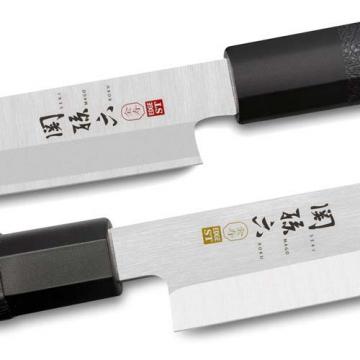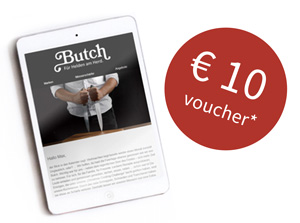
KAI Seki Magoroku Kinju & Hekiju
So much expertise for so little money … ?! Honestly, we at Butch were a bit skeptical at first – until we personally verified the quality of these knives … Since then, they have become our favorites. The price/performance ratio of this series is simply great. And if you don't immediately share our enthusiasm after your first cutting attempts: It's not the knives, it's the technique. It takes some practice, meaning skill, to properly handle these typically Japanese knives. So get to it! Because practice makes perfect (knife) master ...
Notably: The chef's knives of the KAI series Seki Magoroku Kinju & Hekiju are single-edged. The blades of the seven Kinju knives are ground on the right side of the knife and are suitable for right-handers, while the two Hekiju blades are ground on the left and are specially made for left-handers.
This kitchen knife collection impresses with its high functionality and durability. The knives are lightweight and allow for fatigue-free work. But what would all the inner values be without an appealing appearance? This convinces at first glance: The typically Japanese blade shape combined with the simple black handle gives these knives a minimalist aesthetic and a cultivated elegance.
The Blade
In the production of the blades, the KAI knife forge uses special manufacturing technologies. This makes it possible to achieve the demanding, pointed cutting edges of traditional Japanese kitchen knives. The extremely precise processing of the edge achieves maximum blade sharpness.
The Seki Magoroku Kinju & Hekiju blades are single-edged. As mentioned, with a little practice, you get a steeper angle to the cutting material when cutting, compared to double-edged knives. Single-edged blades allow for very precise cuts, for example, for fine filleting. The cutting surfaces are extremely smooth. No fiber stands out here, and not the slightest irregularity occurs.
The Handle
The slightly hexagonal handle of the KAI Kinju knives is made of laminated, reinforced wood. By using high-quality natural wood, which has been treated with a special process, the handle provides a pleasant feeling when cutting and is also extremely water-resistant. The handle of the KAI Hekiju knives, developed for left-handers, is rounded and made of robust resin with a leather-like embossing.







